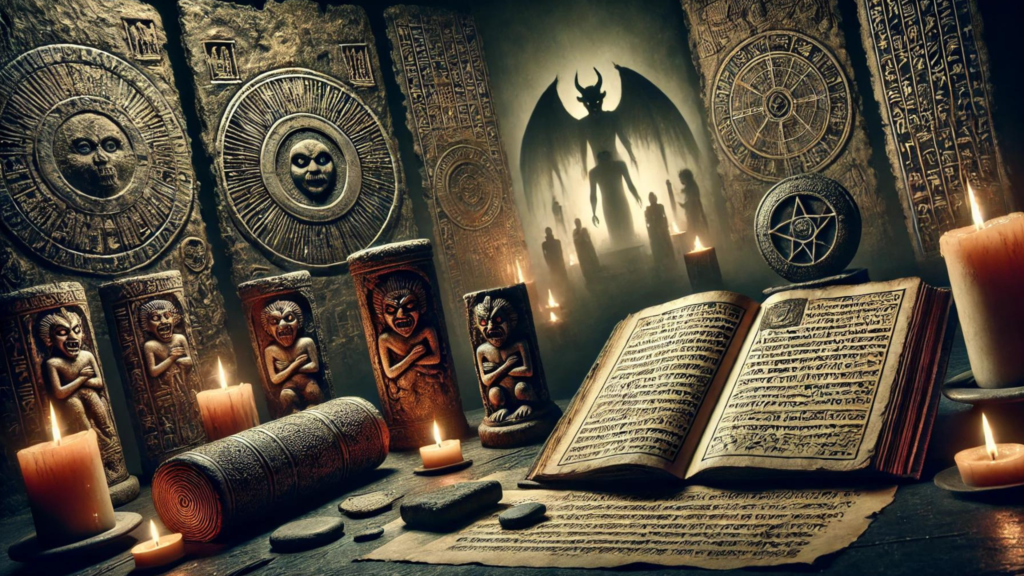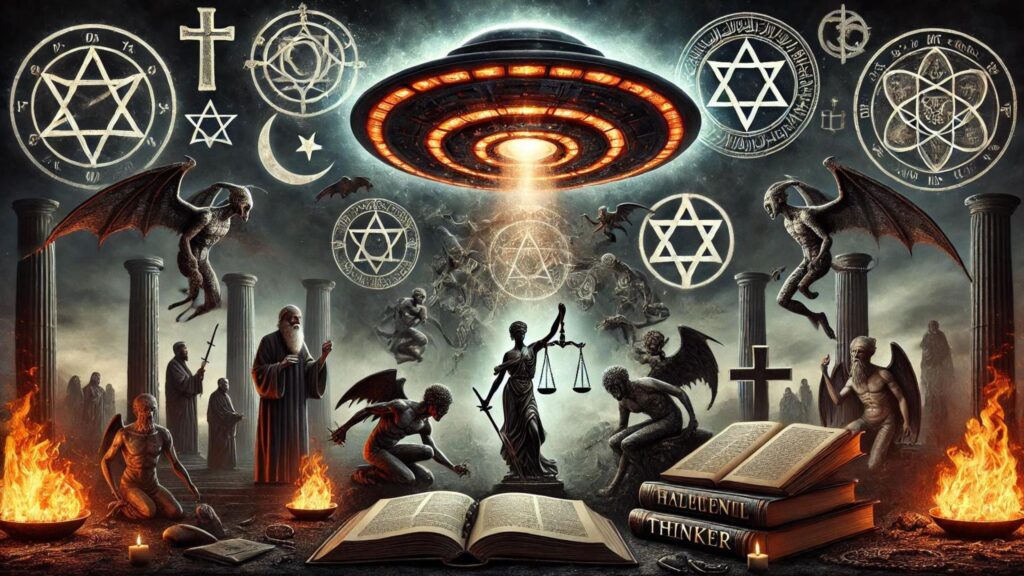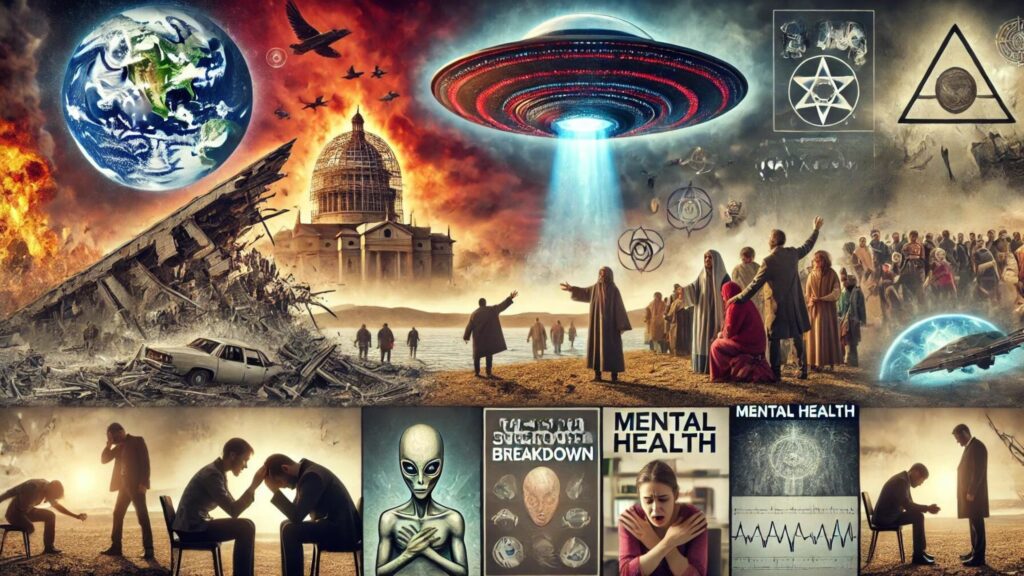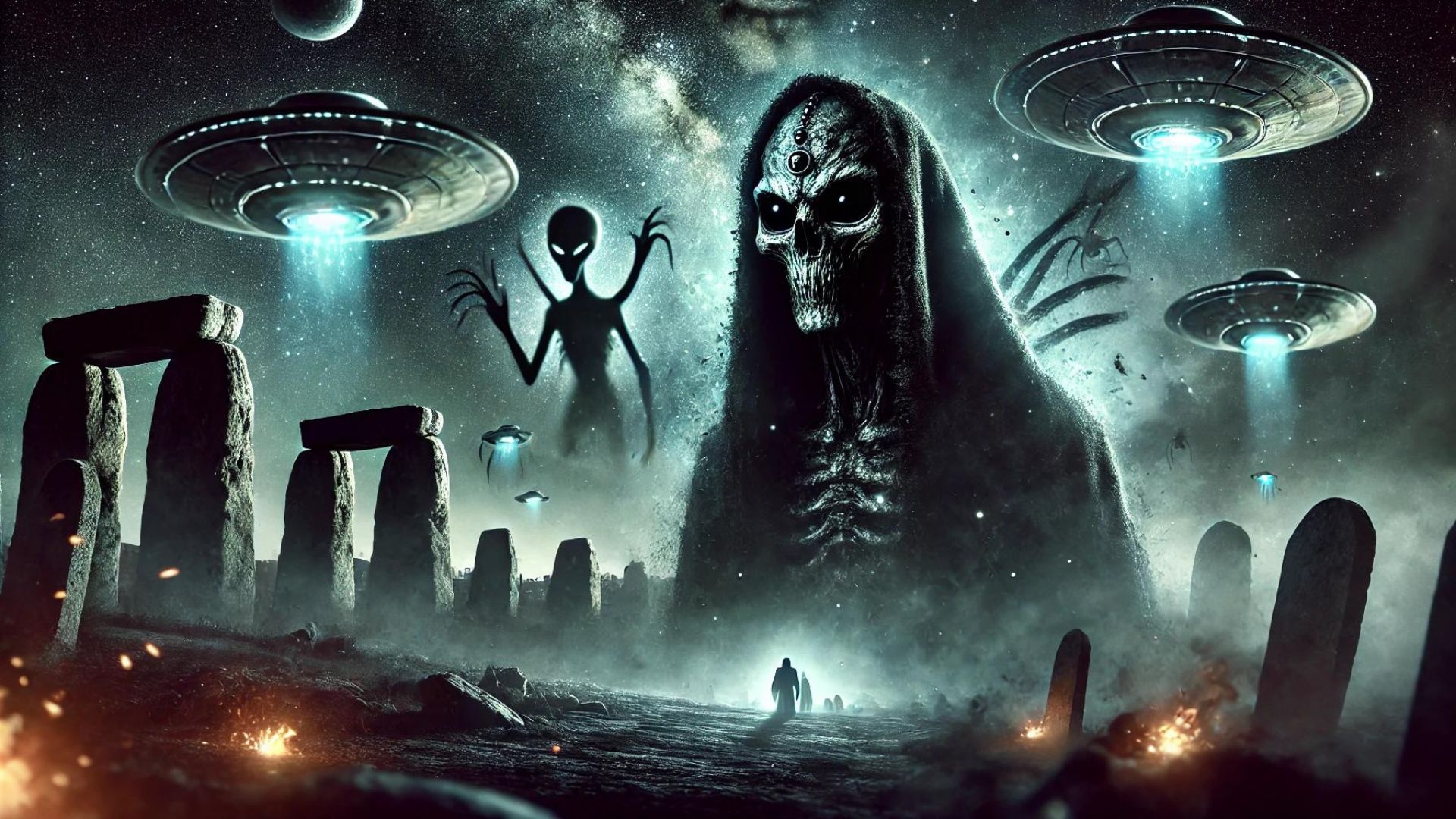Introduction
The recent surge in UFO sightings and government disclosures about unidentified aerial phenomena (UAP) has captured public attention like never before. While many hope that the disclosure of Non-Human Intelligence (NHI) will bring about a new era of understanding, there is a growing concern that these entities may not be as benevolent as we wish. Instead, they could represent malevolent forces with potentially demonic characteristics. This unsettling possibility challenges our perceptions and forces us to consider the darker side of alien disclosure.
Historical Context of Malevolent NHI

Ancient Accounts
Throughout history, many cultures have recorded encounters with non-human entities often described as demons. These accounts, found in ancient texts and mythologies, offer a glimpse into how early civilizations perceived and interpreted these mysterious beings.
The Bible: One of the most well-known references comes from the Bible, which mentions the Nephilim. Described as giants born from the union of “the sons of God” and human women, the Nephilim are often viewed as malevolent beings with supernatural origins.
Ancient Sumerian Writings: Sumerian texts also describe encounters with non-human entities. These beings, sometimes depicted as gods or spirits, were often feared and revered for their otherworldly powers.
Islamic Texts: In Islamic mythology, the Djinn are supernatural beings created from smokeless fire. While some Djinn are considered benevolent, many are believed to be malevolent and capable of causing harm to humans.
Folklore: Various cultures have their own versions of demonic figures. For example, European folklore is rich with tales of malevolent spirits and demons, often used to explain unexplained phenomena and instill moral lessons.
Medieval and Renaissance Demonology
The Middle Ages and Renaissance periods saw a heightened interest in the study of demons and malevolent spirits. This era of demonology sought to classify and understand these entities, often blending religious, philosophical, and occult perspectives.
John Dee and Edward Kelley: Among the most notable figures in this field were John Dee and Edward Kelley. Dee, an English mathematician, astronomer, and advisor to Queen Elizabeth I, and Kelley, his associate, were deeply involved in the exploration of Enochian magic. They claimed to communicate with angels and other non-human intelligences, using a complex system of symbols and rituals. Some of these entities were described in terms that suggested a malevolent nature, raising questions about their true origins.
Demonology Texts: During this period, numerous texts were written to catalog and describe demons and other malevolent spirits. Works such as the “Malleus Maleficarum” and “Dictionnaire Infernal” provided detailed descriptions of demonic hierarchies, attributes, and the methods by which these beings could be summoned or banished.
Cultural Impact: The fear of demons influenced various aspects of medieval and Renaissance life, from art and literature to legal systems and religious practices. This period’s fascination with demonic entities reflects a broader concern with the unknown and the potentially malevolent forces that might lurk beyond the visible world.
These historical accounts and studies highlight humanity’s long-standing fear and fascination with malevolent non-human entities. By examining these ancient and medieval perspectives, we gain insight into the deep-rooted anxieties that continue to shape our interpretations of NHI today.
Modern Encounters and Interpretations

Ufology and Paranormal Studies
In the modern era, several UFO encounters have sparked fear and speculation about the true nature of Non-Human Intelligence. These cases often carry negative or frightening aspects, suggesting that some interactions with NHI might be malevolent.
The abduction of Betty and Barney Hill in 1961 is one of the most well-documented and chilling UFO cases. The couple reported being taken aboard a spacecraft and subjected to medical examinations by non-human entities. Their detailed accounts and the trauma they experienced have fueled theories about the darker intentions of these beings.
Similarly, Travis Walton’s abduction in 1975 remains a significant and disturbing case. Walton was reportedly taken by a UFO and disappeared for five days, only to return with fragmented memories of his ordeal. His experience, characterized by fear and confusion, further suggests that not all alien encounters are benign.
The Skinwalker Ranch in Utah is another hotspot for paranormal activity and frightening UFO encounters. The ranch has been the site of numerous bizarre incidents, including sightings of strange creatures, unexplained lights, and violent animal mutilations. These events contribute to the theory that some UFO phenomena may have sinister origins.
Paranormal Investigations
Modern-day paranormal investigations often reveal connections between UFO sightings and demonic encounters. Prominent investigators have explored these eerie links, suggesting that some alien encounters might be more than just visits from extraterrestrial beings.
Ed and Lorraine Warren, renowned paranormal investigators, have encountered cases where UFO sightings and demonic activity intersect. Their work in the field has highlighted the potential for some alien entities to possess malevolent, even demonic, characteristics.
Authors like John Keel, known for “The Mothman Prophecies,” have delved into high strangeness, a term describing bizarre and seemingly interconnected paranormal phenomena. Keel’s research suggests that the lines between UFOs, cryptids, and demonic entities are often blurred, indicating a shared origin or purpose.
Jacques Vallée, a respected figure in UFO studies, has also explored the high strangeness aspect of these encounters. Vallée’s work points to the possibility that some NHI might be manipulating human perception and experiences for unknown, possibly malevolent, reasons.
These modern encounters and interpretations offer a sobering perspective on the potential nature of NHI. By examining these frightening cases and paranormal investigations, we can better understand the complexities and possible dangers of alien disclosure.
Theological and Philosophical Perspectives

Religious Views on NHI
Various religions have long grappled with the concept of non-human entities, often interpreting them as demonic beings. These perspectives offer a profound insight into how ancient beliefs might intersect with modern interpretations of NHI.
Christianity: In Christian demonology, demons are fallen angels who rebelled against God. Texts like the Bible describe these beings in sinister terms. For instance, the Nephilim, mentioned in Genesis 6:4, are seen as the offspring of these fallen angels and human women. Theologians like St. Augustine (354-430 AD) and Thomas Aquinas (1225-1274 AD) have written extensively on the nature and hierarchy of demons, further embedding the idea of malevolent non-human entities in Christian thought.
Islam: Islamic teachings also include references to supernatural beings that can influence human affairs. The Quran describes Djinn as creatures made from smokeless fire, capable of both good and evil. Notably, Surah Al-Hijr (15:27) and Surah Al-Jinn (72:1-15) discuss the Djinn’s interactions with humans. Islamic scholar Ibn Taymiyyah (1263-1328) wrote about the dangers posed by malevolent Djinn, likening them to the Christian concept of demons.
Hinduism: In Hinduism, Asuras are powerful beings often opposed to the Devas (gods). Texts like the Rigveda (circa 1500-1200 BCE) and the Mahabharata (circa 400 BCE-400 CE) depict Asuras as demonic forces constantly at odds with divine entities. The philosopher Adi Shankaracharya (788-820 AD) elaborated on these conflicts, interpreting them as the eternal struggle between good and evil.
Philosophical Implications
Interpreting NHI as demonic forces brings significant philosophical questions to the forefront. These interpretations challenge our understanding of morality, existence, and humanity’s place in the universe.
Good and Evil:If NHI are indeed malevolent, what does this mean for our concepts of good and evil? Philosophers like Immanuel Kant (1724-1804) and Friedrich Nietzsche (1844-1900) have explored the nature of morality and the human tendency to classify experiences within these binary terms. The existence of malevolent NHI would force a reevaluation of these philosophical foundations.
Humanity’s Place in the Universe: The potential malevolence of NHI also impacts our view of humanity’s significance. Existentialist philosophers such as Jean-Paul Sartre (1905-1980) and Albert Camus (1913-1960) questioned human purpose in an indifferent universe. The idea that humanity might be subject to the whims of malevolent NHI adds a layer of existential dread to these discussions, prompting deeper reflections on our vulnerability and resilience.
These theological and philosophical perspectives highlight the profound implications of interpreting NHI as demonic entities. By examining religious teachings and philosophical inquiries, we gain a deeper understanding of how these interpretations shape our worldview and challenge our fundamental beliefs.
Scientific and Skeptical Analysis

Psychological Explanations
Several psychological theories explain why people might interpret encounters with Non-Human Intelligence (NHI) as demonic. These theories provide a scientific basis for understanding the fear and paranoia associated with such experiences.
Sleep Paralysis: One of the most common explanations is sleep paralysis, a condition where a person is conscious but unable to move, often accompanied by terrifying hallucinations. Research by Dr. J. Allan Cheyne, a professor at the University of Waterloo, has shown that these hallucinations often involve shadowy figures or demonic entities. This condition could explain why people report seeing malevolent beings during episodes of sleep paralysis.
Mass Hysteria: Mass hysteria, or collective delusions, is another psychological phenomenon that can lead to widespread fear of demonic NHI. Historical instances, such as the Salem witch trials in 1692, demonstrate how fear can spread rapidly through a community, leading to collective belief in malevolent forces. Modern examples include panic over supposed alien abductions, where cultural narratives and media influence can amplify fear and paranoia.
Cultural Narratives: The influence of cultural narratives plays a significant role in shaping our perceptions of NHI. Movies, books, and folklore often depict aliens as sinister beings. These stories can prime individuals to interpret ambiguous or frightening experiences as encounters with demonic NHI. Dr. Elizabeth Loftus, a renowned psychologist, has extensively studied how memory and perception can be influenced by external narratives, leading people to construct elaborate and terrifying accounts of their experiences.
Skeptical Perspectives
Skeptics argue that many reports of demonic NHI are based on misidentifications, psychological phenomena, or deliberate fabrications. They emphasize the importance of critical thinking and scientific inquiry in addressing these claims.
Carl Sagan: In his book “The Demon-Haunted World” (1995), Carl Sagan explores how science can provide explanations for phenomena often attributed to the supernatural. Sagan argues that many accounts of demonic NHI are rooted in a lack of understanding of natural and psychological processes. He advocates for scientific literacy and skepticism to combat the fear and misinformation surrounding these encounters.
James Randi: James Randi, a well-known skeptic and magician, dedicated his career to debunking paranormal claims. Through his investigations, Randi demonstrated how easily people can be deceived by charlatans and misinterpret natural phenomena as supernatural events. His work, including the $1 million challenge to anyone who could prove paranormal abilities under controlled conditions, highlights the importance of rigorous testing and skepticism in evaluating claims of demonic NHI.
These psychological and skeptical analyses provide a grounded perspective on the fear and paranoia associated with NHI. By understanding the scientific and psychological underpinnings of these experiences, we can better address the anxieties and misconceptions that fuel the belief in malevolent extraterrestrial beings.
Potential Consequences of Malevolent NHI Disclosure

Societal Impact
The disclosure that Non-Human Intelligence (NHI) might be malevolent or demonic could trigger profound and far-reaching consequences for society. The immediate reaction could range from panic to a complete upheaval of existing societal structures.
Panic: Widespread fear and panic would likely be the initial response. The revelation that malevolent beings exist beyond our understanding could cause chaos, leading to irrational behavior, hoarding, and an increase in conspiracy theories. Historical examples, such as the War of the Worlds radio broadcast in 1938, show how easily mass hysteria can be induced by the perceived threat of alien invasion.
Religious Fervor: Religious communities might react with fervor, interpreting the malevolent NHI as a sign of the end times or divine intervention. This could lead to increased attendance at religious services, revivalist movements, and potentially even cult-like behaviors. Some might see it as a call to repentance or a battle between good and evil, as described in their religious texts.
Breakdown of Societal Norms: The fear and uncertainty surrounding malevolent NHI could cause a breakdown of societal norms. Trust in government and scientific institutions might erode if they are seen as complicit in hiding the truth. Social cohesion could weaken, with communities turning inward and becoming more suspicious of outsiders. The social fabric could be strained as people struggle to make sense of the new reality.
Preparation and Coping Strategies
Preparing for the potential disclosure of malevolent NHI involves proactive measures to mitigate panic and promote resilience. These strategies can help society cope with the profound implications of such a revelation.
Public Education: Educating the public about the nature of NHI and the potential for malevolent entities is crucial. Transparent communication from government and scientific institutions can help dispel myths and reduce fear. Educational campaigns should focus on providing factual information and encouraging critical thinking.
Fostering Open-Mindedness: Promoting open-mindedness and tolerance is essential in preparing for the societal impact of NHI disclosure. Encouraging diverse perspectives and fostering dialogue can help people process the information and reduce the likelihood of extreme reactions. Communities should be encouraged to come together to discuss and understand the implications of NHI.
Promoting Mental Health Support: The psychological impact of discovering malevolent NHI could be significant. Providing mental health support, including counseling and crisis intervention, can help individuals cope with anxiety and fear. Mental health professionals should be prepared to address the unique challenges posed by the disclosure of malevolent entities.
These strategies aim to build a resilient society capable of facing the potential revelation of malevolent NHI. By fostering education, open-mindedness, and mental health support, we can better prepare for the profound and unsettling possibilities that lie ahead.
Conclusion

The possibility that Non-Human Intelligence (NHI) could be malevolent forces, possibly even demonic, has profound implications across various aspects of our understanding and existence.
We explored historical accounts where ancient texts and mythologies described encounters with entities perceived as demons. We examined modern encounters, such as the Betty and Barney Hill abduction and incidents at Skinwalker Ranch, which suggest frightening aspects of these beings. Theological perspectives from Christianity, Islam, and Hinduism offer further insights into how NHI might be interpreted as demonic entities. Philosophically, the existence of malevolent NHI challenges our concepts of good and evil and humanity’s place in the universe. Scientific and skeptical analyses provide psychological explanations for these fears, highlighting the importance of critical thinking and skepticism. Finally, we considered the potential societal impact of such a revelation, including panic and religious fervor, and discussed strategies to prepare and cope with these profound changes.
**Closing Thought:** While the disclosure of NHI could indeed bring about fear and uncertainty, it also presents a unique opportunity for humanity to confront and understand the deeper mysteries of our existence. By preparing for any eventuality with resilience and critical thinking, we can turn a potentially terrifying revelation into a catalyst for growth and understanding.


